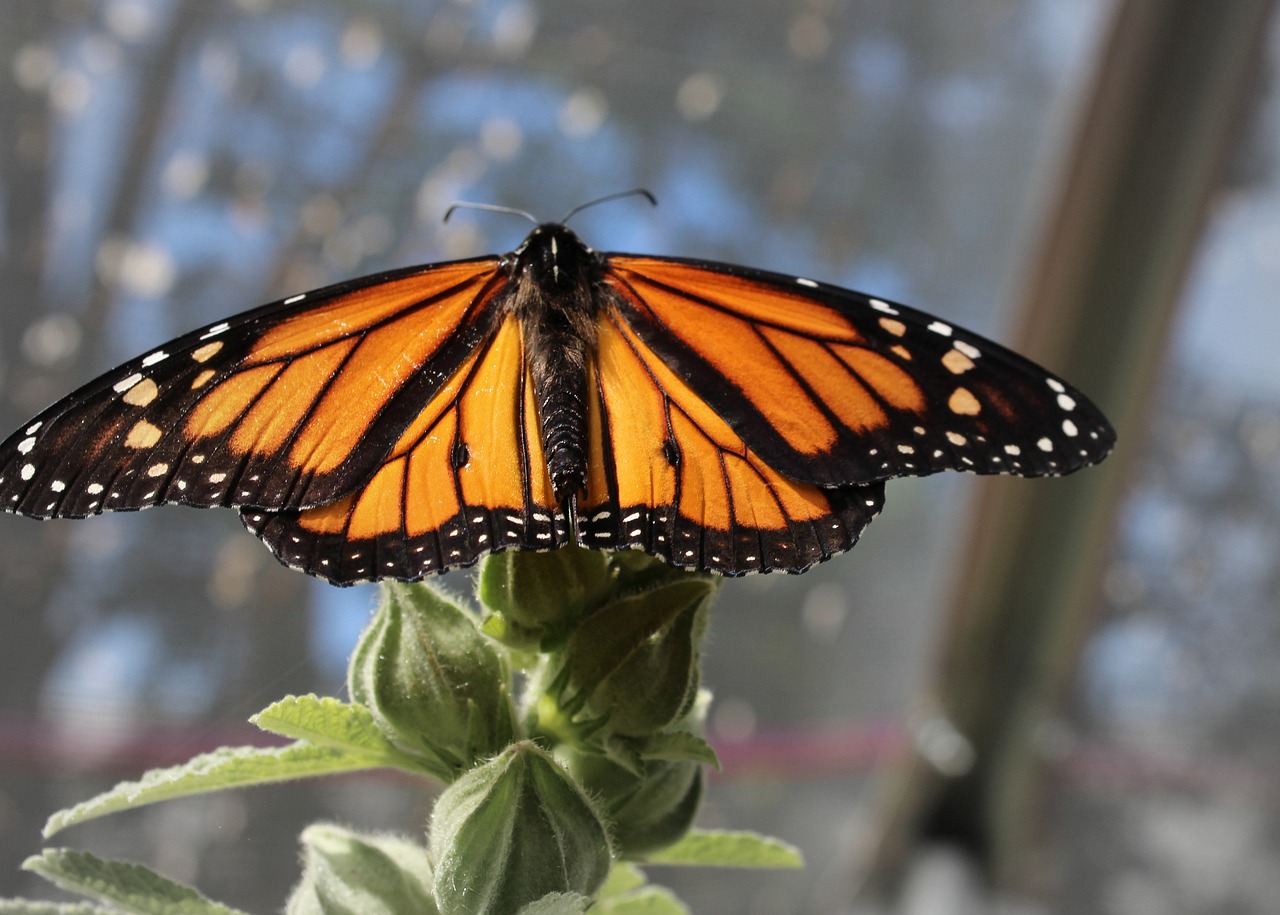Monarch butterflies employ several defense mechanisms against predators, including toxic chemical compounds, mimicry, and behavioral adaptations. These strategies not only deter potential threats but also enhance their survival rates in the wild.
Monarch butterflies, known for their striking orange and black coloration, are not just beautiful creatures but also fascinating examples of evolutionary adaptation. These butterflies are primarily found in North America and are famous for their long migrations. However, their vibrant appearance is a warning signal to potential predators. This warns them of the butterflies’ unpalatable taste due to the toxins they accumulate during their larval stage from consuming milkweed plants.
The monarch’s relationship with milkweed is crucial for its survival. The caterpillars feed exclusively on milkweed, which contains toxic compounds called cardenolides or cardiac glycosides. These substances are harmful to many animals, making the caterpillars distasteful and often lethal if consumed. This toxicity is not only retained into adulthood but is also a key factor in the monarch’s defense strategy against birds and other predators.
Defense Mechanisms of Monarch Butterflies

Monarch butterflies utilize multiple defense mechanisms that can be categorized into chemical, physical, and behavioral strategies. Each mechanism plays a vital role in ensuring their survival in a world filled with threats from various predators.
Chemical Defenses
The most prominent defense mechanism of the monarch butterfly is chemical. The toxins derived from milkweed serve as a powerful deterrent. Birds that consume monarchs often experience negative effects, leading them to associate the butterfly’s bright colors with an unpleasant experience.
| Defense Mechanism | Description |
|---|---|
| Toxic Compounds | Accumulated from milkweed, making them distasteful to predators. |
| Mimicry | Similar appearance to toxic species deters predation. |
| Behavioral Adaptations | Flight patterns and hiding strategies to avoid detection. |
Mimicry and Warning Coloration
Another effective strategy employed by monarch butterflies is mimicry. Their bright coloration not only signals toxicity but also helps them blend in with other unpalatable species. This form of mimicry provides a significant advantage as it confuses potential predators that may have learned to avoid similarly colored but toxic insects.
Additionally, the concept of warning coloration extends beyond just mimicry. The striking colors of the monarch serve as a bold statement to predators. This visual cue reinforces the idea that the butterfly is not worth the risk of consuming, thus improving its chances of survival.
Behavioral Defenses
Behavior also plays a crucial role in the defense mechanisms of monarch butterflies. These insects exhibit specific flight patterns that make them difficult to catch. Their erratic flying style can confuse predators, allowing them to escape potential threats more easily.
Moreover, monarchs often seek refuge in dense vegetation or amongst flowers where they are less visible to predators. This behavior not only aids in camouflage but also minimizes encounters with birds and other insectivorous animals.
Additional Defense Strategies
In addition to chemical defenses, mimicry, and behavioral adaptations, monarch butterflies have developed several other strategies to enhance their survival against predators. These strategies include the use of physical adaptations, environmental interactions, and even community behaviors that contribute to their defense.
Physical Adaptations
Monarch butterflies possess certain physical traits that aid in their defense. These adaptations not only help them evade predators but also enhance their overall survival in various environments.
- Wing Structure: The structure of a monarch’s wings allows for agile flight. Their wings can maneuver sharply, which helps them dodge predators more effectively.
- Size and Coloration: The size and bright coloration of the monarch can serve as a warning to some potential predators. Larger butterflies may be perceived as more dangerous or toxic.
- Camouflage Patterns: While their vibrant colors serve as a warning, the patterns on their wings can also provide some camouflage when they rest on flowers or amongst leaves.
Environmental Interactions
The environment plays a crucial role in the defense mechanisms of monarch butterflies. Their habitat choices can significantly influence their vulnerability to predation.
Monarchs are known to inhabit areas with abundant milkweed, which is essential for their lifecycle. However, they also seek out environments that provide shelter and resources to enhance their survival:
- Diverse Habitats: Monarchs thrive in varied habitats, including meadows, fields, and gardens. These diverse environments not only provide food sources but also offer numerous hiding spots from predators.
- Migration Patterns: During migration, monarchs often travel in large groups. This communal behavior can reduce individual risk as the sheer number of butterflies can overwhelm predators.
- Seasonal Timing: Monarchs time their life cycles to avoid peak predator seasons. By emerging at specific times, they can reduce encounters with larger populations of predators.
Community Behaviors
Monarch butterflies engage in various community behaviors that enhance their chances of survival. These social interactions can be beneficial in multiple ways:
- Group Roosting: Monarchs often roost together in large numbers during migration. This collective behavior provides warmth and protection from predators during resting periods.
- Information Sharing: By being in a group, butterflies may benefit from shared knowledge about safe feeding areas or resting spots that are less likely to attract predators.
- Predator Vigilance: When in groups, individuals can be vigilant against threats. If one butterfly detects danger, it can alert others, increasing overall survival rates.
The Role of Natural Predators
Understanding the role of natural predators is essential to comprehending the defense mechanisms of monarch butterflies. The presence of various predators has influenced the evolution of these butterflies’ defenses over time.
Common predators of monarch butterflies include:
- Birds: Many birds are natural enemies of monarch butterflies. Their learning ability to associate bright colors with toxicity has been pivotal in shaping the monarch’s defensive strategies.
- Insects: Certain insects, such as spiders and dragonflies, also pose threats to monarchs. The butterflies’ ability to evade capture is critical for avoiding these predators.
- Mammals: Small mammals may occasionally prey on monarch larvae. The toxicity acquired from milkweed serves as a deterrent even at the caterpillar stage.
The dynamic relationship between monarch butterflies and their predators highlights the ongoing evolutionary arms race between prey and predator. As predators adapt and develop new hunting strategies, monarchs must evolve their defenses accordingly to survive in an ever-changing environment.

Impact of Environmental Changes on Monarch Defense Mechanisms

As environmental conditions fluctuate due to climate change and habitat loss, the defense mechanisms of monarch butterflies are also impacted. These changes can affect the availability of resources, the presence of predators, and the overall survival strategies of these exquisite insects.
Climate Change Effects
Climate change poses significant threats to the habitats of monarch butterflies. Changes in temperature and precipitation patterns can influence the growth and distribution of milkweed, which is essential for their lifecycle.
- Milkweed Availability: Shifts in climate can lead to reduced milkweed growth in certain areas. This decrease directly impacts caterpillar survival rates since they rely solely on milkweed for food.
- Migration Patterns: Monarchs are known for their long migratory journey. Climate change can alter the timing of these migrations. If temperatures rise too quickly, it may disrupt their life cycle and lead to mismatches between migration timing and resource availability.
- Increased Predation: Warmer temperatures can result in a higher population of predators. An increase in predator populations may put additional pressure on monarchs, forcing them to adapt their defense mechanisms more rapidly.
Habitat Loss and Fragmentation
The loss of natural habitats due to urbanization and agricultural expansion further complicates the survival of monarch butterflies. Habitat fragmentation can lead to isolated populations that struggle to thrive.
- Reduced Shelter: The loss of dense vegetation limits the hiding places available for monarchs. With fewer areas to conceal themselves, the risk of predation increases significantly.
- Disrupted Migration Routes: Urban development can obstruct migration pathways. Monarchs may find it challenging to navigate through fragmented landscapes, which can affect their ability to reach breeding and feeding grounds.
- Inbreeding Risks: Isolated populations may face genetic bottlenecks. Reduced genetic diversity can weaken the overall resilience of these populations against environmental stressors and diseases.
Human Impact on Monarch Survival
Human activities play a critical role in shaping the survival strategies of monarch butterflies. Conservation efforts and awareness initiatives can either enhance or hinder their defense mechanisms.
Conservation Efforts
Several conservation initiatives aim to protect monarch habitats and ensure the survival of this iconic species. These efforts can positively influence their defense mechanisms by providing essential resources and fostering population growth.
- Milkweed Planting: Community-led efforts to plant milkweed in gardens and public spaces contribute significantly to monarch recovery. By increasing the availability of their food source, these initiatives can help sustain caterpillar populations.
- Habitat Restoration: Restoring natural habitats can provide shelter and breeding grounds crucial for monarchs. Conservation programs often focus on re-establishing native flora that supports the entire ecosystem.
- Awareness Campaigns: Educational initiatives raise awareness about the importance of monarchs and their role in ecosystems. By informing the public, these campaigns can foster community support for conservation efforts.
Pesticide Use and Its Consequences
The widespread use of pesticides in agriculture poses significant risks to monarch populations. Pesticides can have detrimental effects on both adult butterflies and their larvae.
- Toxicity to Caterpillars: Chemical pesticides can directly harm caterpillars feeding on milkweed, leading to reduced survival rates.
- Disruption of Ecosystems: Pesticides can alter the balance of local ecosystems, leading to a decline in plant biodiversity, including milkweed, further threatening monarch populations.
- Impact on Adult Butterflies: Adult monarchs exposed to pesticides may experience impaired flight abilities, which reduces their ability to evade predators and find suitable habitats.
The interplay between environmental changes, human impact, and the defense mechanisms of monarch butterflies creates a complex web of challenges for their survival. Understanding these factors is essential for developing strategies that support the continued existence of this remarkable species.
Future Prospects for Monarch Butterflies

As we look toward the future, it is crucial to consider the ongoing research and conservation efforts aimed at protecting monarch butterflies. Scientists and conservationists are actively studying the impacts of climate change, habitat loss, and human activities to better understand how these factors influence the defense mechanisms of monarchs.
One promising area of research involves identifying resilient populations that may adapt to changing environmental conditions. By studying these populations, researchers can gain insights into how monarchs might evolve their defense strategies in response to new threats. Additionally, there is a growing emphasis on the importance of genetic diversity within monarch populations. Maintaining genetic diversity is vital for ensuring the adaptability and long-term survival of these butterflies in a rapidly changing world.
Community Involvement and Education
Active community involvement plays a significant role in the conservation of monarch butterflies. Local initiatives can make a substantial difference in providing habitats and resources essential for their survival.
- Citizen Science Projects: Engaging the public in monitoring and reporting butterfly sightings can aid scientists in tracking population dynamics and migration patterns. This data is invaluable for conservation efforts.
- Educational Programs: Schools and organizations can implement programs that educate young people about the importance of monarchs and their ecosystems. By fostering a sense of stewardship, these programs encourage future generations to protect these remarkable insects.
- Local Gardening Initiatives: Encouraging residents to plant native milkweed and nectar-producing flowers in their gardens can create essential habitats. These initiatives not only support monarchs but also promote biodiversity in urban areas.
Policy Advocacy
Advocating for policies that protect monarch habitats is another vital component of conservation efforts. Grassroots movements and collaborations with environmental organizations can lead to significant changes at local, state, and national levels.
- Habitat Protection Laws: Supporting legislation aimed at preserving natural habitats can create safe spaces for monarchs to thrive. This includes protecting existing milkweed populations and restoring degraded habitats.
- Pesticide Regulation: Advocating for stricter regulations on pesticide use can help mitigate the harmful effects of chemicals on butterfly populations. Promoting organic farming practices can also reduce pesticide exposure.
- Funding for Research: Encouraging funding for scientific research focused on monarch conservation can lead to innovative solutions for protecting these butterflies from ongoing threats.
Final Thoughts
The defense mechanisms of monarch butterflies are a testament to nature’s complexity and the intricate relationships within ecosystems. These butterflies have evolved a myriad of strategies to survive predators, including chemical defenses, mimicry, and behavioral adaptations. However, as they face increasing pressures from climate change, habitat loss, and human activities, their future hangs in the balance.
Understanding and addressing these challenges require a multifaceted approach involving science, community action, and policy advocacy. By fostering awareness and encouraging conservation efforts, we can help ensure that monarch butterflies continue to grace our landscapes with their beauty for generations to come.
In conclusion, the survival of monarch butterflies relies not only on their remarkable defense mechanisms but also on our collective efforts to protect their habitats and promote biodiversity. By working together, we can create a future where these iconic butterflies thrive amidst a healthy and balanced ecosystem.
